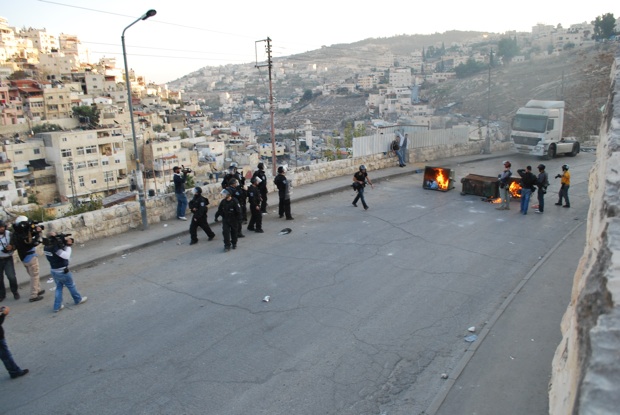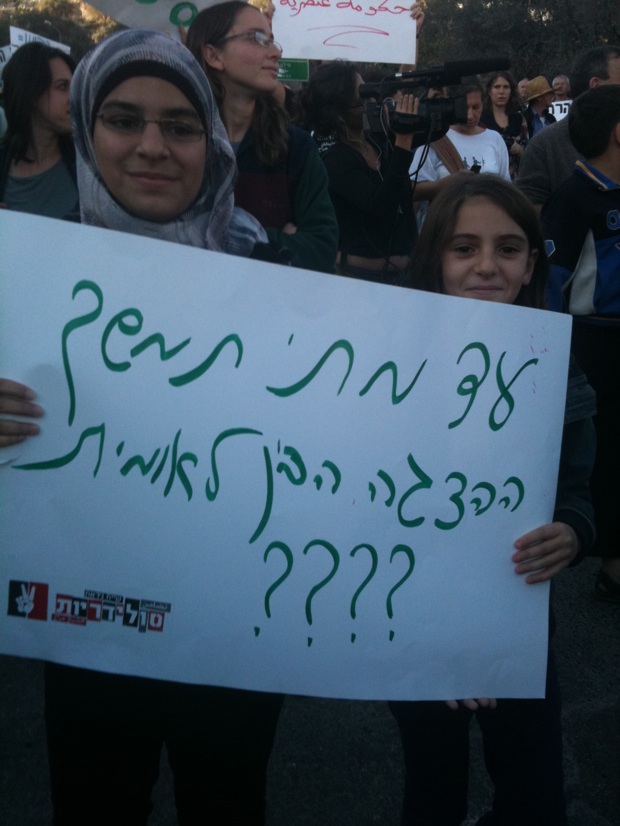What happens before and after an Israeli-Palestinian protest can teach us a lot about the challenge of building trust and the hard work needed in the joint struggle against decades of occupation and segregation.
While the Sheikh Jarrah Solidarity movement has been successfully bringing the story of East Jerusalem neighborhoods such as Sheikh Jarrah, Silwan and Issawiya to the forefront of public debate in Israel, a far less covered aspect of the story is what happens before and after the protests, which reflects the challenges and complexities of organizing acts of civil disobedience amongst Palestinians themselves, between them and Israelis, and all under the jurisdiction of the Israeli military apparatus.
Yesterday’s weekly protest in Sheikh Jarrah was moved to Silwan, where Israelis joined Palestinians in solidarity with one of its residents, Adnan Gheith, who was issued an expulsion order from Jerusalem by Israel’s Home Front Commander, applying a rare defense emergency regulation from pre-state times. (Read more about Adnan’s case here). Hundreds of Israelis and Palestinians walked together from the Wadi Hilweh Information Center down to the tent erected to protest the planned demolition of 22 houses in al-Bustan to make way for a national garden.
Watch a video of the protest:
[youtube]http://www.youtube.com/watch?v=KlnHW16iZsg[/youtube]
During the protest the army and border police were calm and did not interfere. However, what happened before the demonstration started, which happens every Friday in Silwan around the time of morning prayers, is that the Israeli Border Police enter the area to make their presence known and to guard the settlers. As a result, a number of children start throwing rocks to resist their presence, and in return, the army fires tear gas grenades, sometimes in such quantities that it fills houses. This is the routine in Silwan on a Friday.
But yesterday, in light of the protest, the children stopped throwing rocks and cleared the streets for the protest. As troubled as it may be, this is their way of showing that when positive actions are taken, they are eager to cooperate and welcome Israelis. It is also important to note that not only did various factions within Silwan unite for this protest, but so did members from committees in Sheikh Jarrah and Issawiya. Inter-Palestinian cooperation of this nature in East Jerusalem is not so common. Neither are such high and constant levels of public Palestinian-Israeli cooperation, since one of the issues that divide and vex Palestinians most is suspecting one another of being “collaborators” with Israel.
Once the protest ended and the buses carrying Israelis back to West Jerusalem and Tel Aviv drove off, Silwan residents were left alone with the border police who remained in the area in full riot gear, even though there was no need for them to remain there. The children resumed throwing rocks and began lighting garbage and tires on fire. Again, this is the childrens’ way of showing the authorities which kind of visitors they accept and which they do not.

This is different from what happened at the protest held in Issawiya several weeks ago. There the Palestinian factions were much less united and organized, and some clearly did not endorse the joint Israeli-Palestinian protest. Once the protest there was over, the children threw rocks out of spite, in order to express their dissatisfaction with what had gone on. This is unfortunate, but it is a work in progress. It is important to remember that the Palestinian and Israeli activists who are fighting a joint struggle against Israeli occupation, control and discrimination, are grappling with decades of mistrust and animosity both within their own communities and towards the other. It demands a lot of effort, patience and determination to mend.
Throughout the history of the Israeli-Palestinian conflict, high–ranking politicians and analysts have talked about the need for “confidence-building” measures between Palestinians and Israelis. While the Israeli government and settler organizations continue to imbue hatred, intolerance and aggression in Palestinian East Jerusalem, the activists on both sides who take to the streets are building the trust from the bottom up.
Here is just one example:

The Palestinian girl did not plan to come to the protest, but rather saw it happening from her window, spotted the Israeli girl and decided to come down and join the procession.

